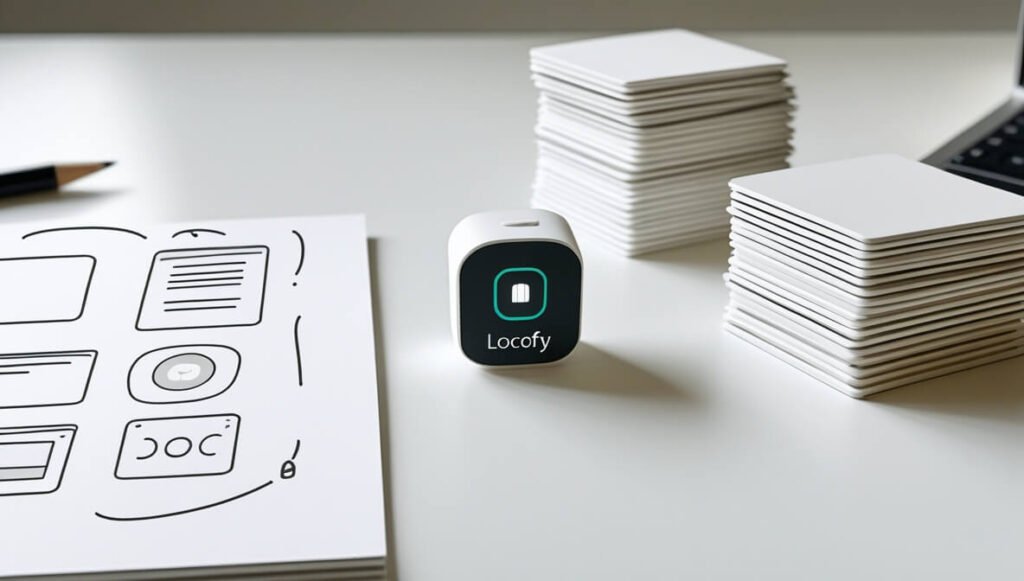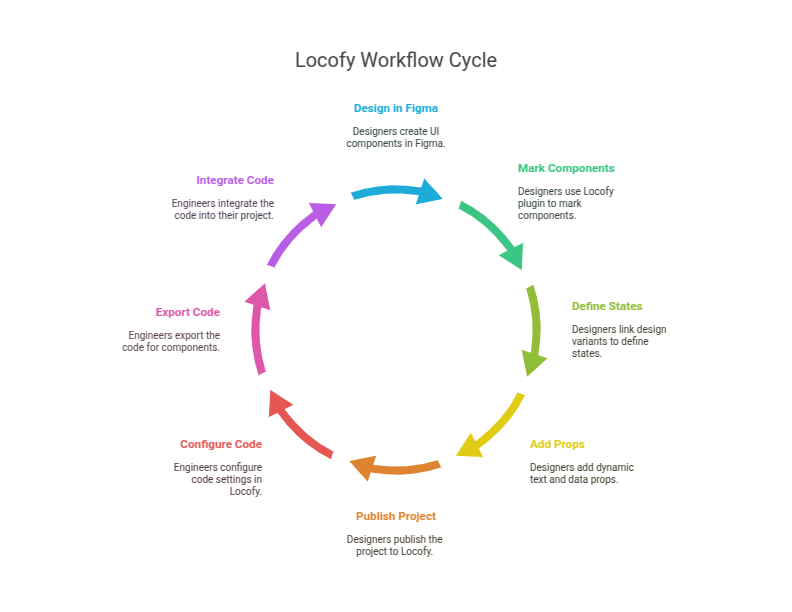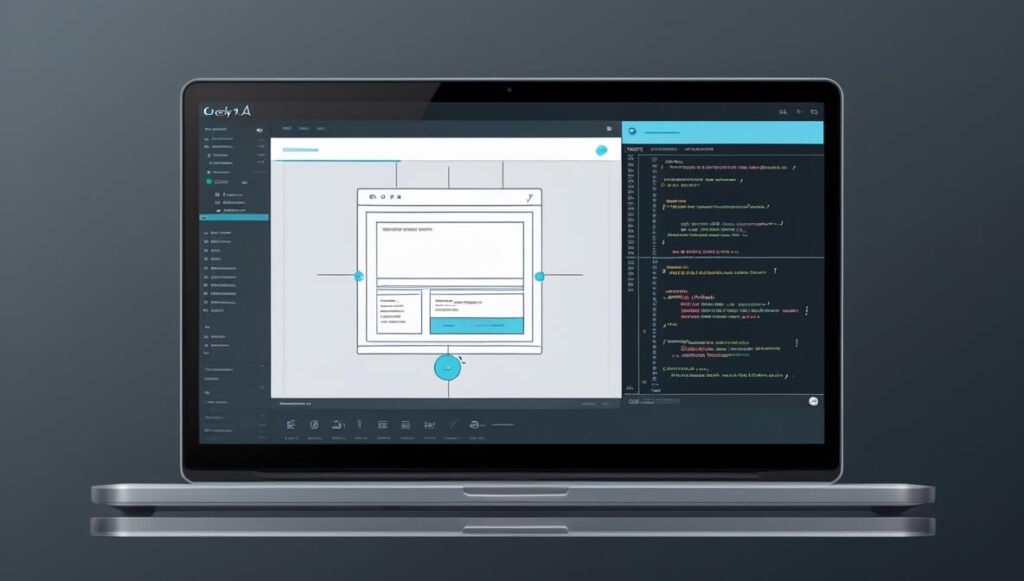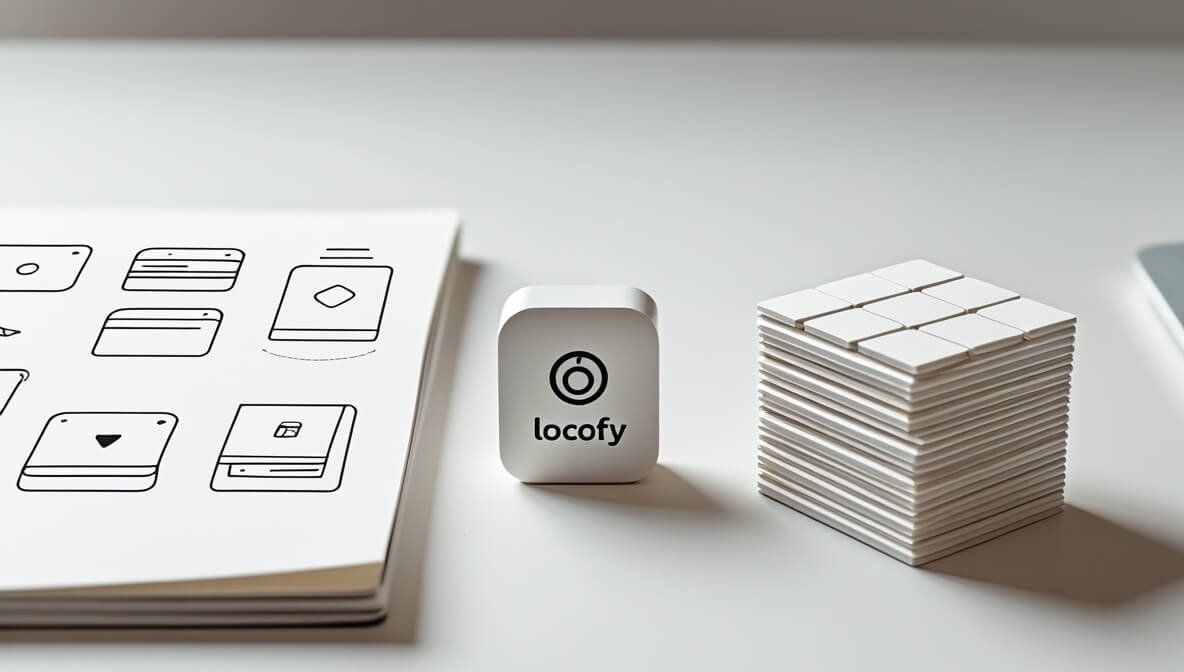Locofy dramatically simplifies Component Generation for Coding and Developing pros. Generate code from designs instantly, save hours, and boost productivity. Stop manual grind, start building faster. Try Locofy today!
How Locofy Is Reshaping Workflows in Coding and Developing
Okay, let’s talk about this whole AI thing.
It’s everywhere, right?
Especially if you’re in Coding and Developing.
The game is changing. Fast.
You’re either adapting, or you’re getting left behind. Simple as that.
One area feeling this shift big time?
Component Generation.
Building those building blocks of your interfaces.
It’s crucial, but honestly, it can be a grind. Repetitive. Time-consuming.
But what if there was a tool that could take a huge chunk of that off your plate?
Enter Locofy.
This isn’t just another AI buzzword.
It’s a tool built specifically for us, the builders. The coders. The developers.
And it’s making waves, particularly when it comes to spitting out clean, usable components from designs.
Ready to see what it can actually do for your workflow?
Let’s get into it.
Table of Contents
- What is Locofy?
- Key Features of Locofy for Component Generation
- Benefits of Using Locofy for Coding and Developing
- Pricing & Plans
- Hands-On Experience / Use Cases
- Who Should Use Locofy?
- How to Make Money Using Locofy
- Limitations and Considerations
- Final Thoughts
- Frequently Asked Questions
What is Locofy?
Alright, first things first. What the heck is Locofy?
Think of it as your co-pilot for turning design files into production-ready code.
Seriously. You feed it a design from Figma, Adobe XD, or Sketch.
Locofy looks at it, understands the structure, and boom.
It starts spitting out frontend code.
We’re talking React, Vue, Angular, HTML/CSS, React Native. The stuff you actually use.
It’s aimed squarely at engineers and designers working together.
The goal? Bridge that gap.
Stop the back-and-forth. Stop the “this doesn’t look like the design” headaches.
And crucially, speed up that painful process of translating pixels into code.
Especially for those repeatable bits.
Yeah, I’m talking about Component Generation.
Instead of manually coding every button, card, or form field based on a design spec.
Locofy gives you a massive head start.
It’s not claiming to replace you. Far from it.
It’s about automating the tedious parts.
Freeing you up to tackle the complex stuff.
The logic, the state management, the integrations. The things only a human engineer can truly nail.
It’s an AI tool, yes, but one built for builders.
One that understands the pain points of going from design to code.
And offers a shortcut. A powerful one.
Ready to see how it specifically helps with components?
Let’s dive into the features.
Key Features of Locofy for Component Generation
- Design-to-Code Conversion (Specifically for Components):
This is the core power play.
You have a design file with perfectly crafted components.
Buttons, cards, navigation bars, input fields, you name it.
Historically, you’d open that design, open your code editor, and start from scratch.
Translating shapes, colours, spacing, fonts.
Tedious. Error-prone.
Locofy connects directly to your design tool.
It reads your layers, groups, and frames.
It identifies potential components based on your design structure.
Then, with some guidance from you (telling it what’s what), it generates the corresponding code.
Not just raw HTML/CSS.
It builds actual functional components in frameworks like React, Vue, or Angular.
With props, states, and even basic interactivity built-in where possible.
This isn’t just a visual copy.
It’s structured code you can actually use and build upon.
Getting from design to a working component in minutes, not hours.
- Smart Component Identification and Structuring:
Locofy doesn’t just guess.
It uses AI to look at your design file.
It understands concepts like reusability.
If you’ve designed something multiple times, it flags it as a potential component.
You can then easily group layers in your design tool and tell Locofy, “Hey, this is a button component.”
Locofy learns.
It helps you define states (hover, active, disabled).
It helps you define props (what text goes here, what image goes there).
It translates Auto Layout in Figma or Stacks in Sketch into Flexbox or CSS Grid.
It understands constraints and responsiveness.
This structuring is key.
It means the code isn’t just a mess of divs.
It’s organised, maintainable code ready to be integrated into your project.
It respects the design system you’ve (hopefully) built.
- Collaboration and Handover Features:
Component Generation isn’t just about the code.
It’s also about the handoff.
The communication between designers and engineers.
Locofy acts as a bridge here.
Designers can use the Locofy plugin in their design tool.
They can mark layers as components, define states, add notes.
Engineers get a link to the Locofy project.
They see the design side-by-side with the generated code.
They can inspect elements.
They can see the defined components and generate the code for them.
This reduces guesswork.
It ensures everyone is on the same page.
No more “how is this button supposed to behave?” emails.
The information is right there, linked directly to the code generation.
Making the component creation process smoother for everyone involved.
Less friction, more building.
Benefits of Using Locofy for Coding and Developing

Okay, so the features sound cool, but what’s the actual win here?
Why should you, a busy engineer or developer, care about Locofy?
It boils down to a few key areas.
First off: **Time, glorious time.**
Manually coding components from design can be painfully slow.
Especially the repetitive ones.
Locofy takes that “zero to sixty” part and cuts it down drastically.
You upload the design, configure a few things, and you have a solid code base for your components.
We’re talking hours saved per week. Potentially days on larger projects.
That time isn’t just “saved.”
It’s time you can spend on complex logic.
On optimising performance.
On building new features.
The stuff that actually moves the needle.
Second: **Consistency and Quality.**
Ever coded a button slightly differently in two places?
Or missed a pixel somewhere?
It happens. Humans make mistakes.
Especially when doing repetitive tasks.
Locofy generates code based on the design file itself.
If the design is consistent, the generated component code will be too.
It helps enforce design system standards in the code.
Less room for human error in the translation phase.
The code it generates is clean and structured.
It follows best practices for the chosen framework.
Making it easier to read, understand, and maintain.
Third: **Improved Collaboration.**
The design-to-code handoff can be a source of friction.
Misinterpretations, missing specs, constant questions.
Locofy creates a single source of truth linking the design element directly to its code representation.
Designers can communicate intent through the plugin.
Developers get immediate context.
This streamlines the workflow.
Reduces misunderstandings.
Gets features built faster with fewer revisions.
It’s about building bridges, not walls, between design and engineering teams.
Finally: **Focus on What Matters.**
Let’s be real. Coding basic UI components isn’t always the most stimulating work.
It’s necessary, but it’s not usually the creative problem-solving engineers love.
Locofy takes that necessary but often tedious work off your plate.
It frees your brain space.
Allows you to focus on the unique challenges of your application.
The complex logic, the API integrations, the performance bottlenecks.
The stuff that provides real business value.
Using Locofy for Component Generation isn’t about being lazy.
It’s about being smart.
Automating the automatable.
Leveraging AI to do the heavy lifting on the UI glue code.
So you can concentrate on building the actual product.
That’s a powerful benefit for anyone in Coding and Developing.
Pricing & Plans
Alright, the million-dollar question (hopefully not *literally* a million dollars): What does this cost?
Does Locofy offer a free way to kick the tires?
Yes, they do.
There’s typically a free plan or a free trial.
This is huge. You absolutely need to test a tool like this with your own design files.
See how it handles your specific components.
The free tier is usually limited in features or usage (like number of projects, amount of code export, etc.).
But it’s enough to get a feel for the workflow and the quality of the generated code for Component Generation.
Beyond the free tier, Locofy has paid plans.
These are usually structured around individuals, teams, and larger enterprises.
The individual plan unlocks more projects, more exports, access to premium features like advanced component mapping, better support, etc.
Team plans add collaboration features, shared libraries, and admin controls.
Enterprise is, well, enterprise. Custom pricing, dedicated support, probably on-premise options, etc.
How does it stack up against alternatives?
There are other tools out there promising design-to-code.
Some are more visual builders.
Some are code generators.
Locofy positions itself pretty strongly as a developer-focused tool.
The code quality is generally considered higher and more maintainable than some competitors.
It focuses on getting you 80% of the way there with clean, editable code, rather than 100% with rigid, unmanageable output.
Pricing is competitive for the value it provides in saved developer time.
Think about the hourly rate of an engineer.
If Locofy saves you even a few hours a month on Component Generation, the paid plan likely pays for itself.
The exact figures change, so check their official pricing page for the latest.
But the model is standard: free to try, pay more for more features and usage.
The key is that the free trial lets you validate the core promise for your specific needs before committing cash.
Hands-On Experience / Use Cases

Let’s talk about putting Locofy to work. What does this actually look like in practice?
Imagine this scenario: You’re building a dashboard. It needs cards, tables, buttons, charts, input forms. All standard UI stuff, but each needs to match a specific design exactly.
Without Locofy, you’re looking at days, maybe a week, just coding the basic components.
With Locofy, the process changes.
First, the designer uses the Locofy plugin in Figma.
They’ve already grouped related layers for their design components.
They use the plugin to mark these groups as components in Locofy.
They define button states (idle, hover, pressed) by linking design variants.
They add props, like dynamic text for a card title or the data for a table.
They publish this project to Locofy.
Now, you, the engineer, open the Locofy project link.
You see the design.
You see the list of components the designer marked.
You click on the Card component.
On the right, you see settings to configure the code. Which framework? TypeScript or JavaScript? CSS or styled components?
You select your options.
You hit “Export Code.”
Boom. You get a zip file or a direct sync to your repo with the code for that Card component.
It’s structured. It’s got props. It’s got basic styling matching the design.
You drop that into your project. It works.
You repeat this for the Button, the Input Field, maybe a basic Nav Bar.
Within a few hours, you have the skeletal code for most of your UI components.
Ready for integration.
Ready for adding logic.
This isn’t magic. The code isn’t always 100% perfect for every single edge case.
You’ll likely need to tweak it. Add complex behaviours. Connect it to your state management.
But that’s the point. Locofy handles the boilerplate.
It handles turning visual design attributes into code properties.
It handles the basic structure.
It takes you from zero to 80% in minutes, not hours or days.
Another use case: **Prototyping.**
Need to build a quick, high-fidelity prototype to test with users?
Design it in Figma.
Run it through Locofy.
Get working code for the UI elements.
Add just enough logic to make it clickable or show basic data.
You have a functional prototype much faster than coding it all manually.
The usability from a developer perspective is good.
The interface is clear. The options for code configuration are solid.
It requires some setup and understanding of how Locofy interprets your design file.
But once you get the hang of mapping design elements to code concepts (like components, props, states), it flows well.
The results?
Massive acceleration in the frontend build process.
More consistency between design and code.
Happier designers and developers.
It’s a tool that genuinely delivers on its promise of accelerating Component Generation.
Who Should Use Locofy?
Alright, who stands to gain the most from throwing Locofy into their toolkit?
If you’re involved in building user interfaces from design files, you should probably take a look.
**Frontend Developers:** This is ground zero. If you spend a significant portion of your time translating pixels into code, especially creating and maintaining UI components, Locofy is built for you. It automates the tedious stuff.
**Full-Stack Developers:** Even if you’re not *only* doing frontend, the frontend part still needs to get done. Locofy helps you blast through the UI build so you can get back to the backend logic or database work you might prefer (or need) to focus on.
**Development Teams (Small to Large):** Collaboration is key. Locofy’s features for design-dev handoff and shared component libraries make it valuable for teams. It creates a smoother workflow and ensures everyone is working off the same source of truth for UI components.
**Freelancers and Agencies:** Time is money. The faster you can turn designs into working code, the more projects you can take on or the more profitable your existing projects become. Locofy directly impacts your bottom line by cutting down build time.
**Designers Who Code (or Want Their Designs Coded Accurately):** If you’re a designer frustrated by your vision getting lost in translation, or if you like to dabble in code yourself, Locofy gives you a direct line to code generation from your designs. You can even generate code snippets to hand directly to engineers, leaving less room for misinterpretation.
**Teams Adopting or Maintaining a Design System:** A design system is only valuable if it’s implemented consistently in code. Locofy helps ensure that the components coded match the components designed, making your design system more effective and easier to maintain across projects.
Essentially, anyone involved in the design-to-development workflow for web or mobile apps can benefit.
If you’re still manually coding every single button, card, or form field from scratch based on a static design file…
You’re leaving speed and consistency on the table.
Locofy tackles that problem head-on, making it a valuable asset for a wide range of roles and team structures in Coding and Developing.
How to Make Money Using Locofy

Okay, let’s talk brass tacks. Can you actually turn using Locofy into revenue? Absolutely.
It’s not a tool that *directly* generates money like selling AI-generated art (though you’re generating assets – code!), but it makes you faster and more efficient, which is just another way to print cash.
Here’s how:
- Offer “Design-to-Code” Services:
Clients have design files but no development resources? You bridge the gap.
Position yourself as the expert who can rapidly convert their Figma, Sketch, or Adobe XD designs into clean, functional frontend code.
Specifically, highlight your ability to generate reusable components.
This is a niche service that’s high-value.
Locofy lets you deliver this service way faster than doing it manually.
You can charge a premium because of the speed and quality you offer.
Think: “Send me your design, get production-ready React components back in 48 hours.”
That’s a compelling offer.
- Increase Your Development Speed (and Capacity):
For your existing development projects, Locofy significantly speeds up the frontend build, especially the initial UI setup and Component Generation.
Faster projects mean you can take on more projects.
Or finish existing projects under budget (pocketing the difference).
If you bill hourly, you might bill fewer hours for the UI part, but the increased capacity allows you to take on more billable work overall.
If you bill per project, you finish faster, reducing your costs and increasing your profit margin per project.
It’s pure efficiency translating to profit.
- Build and Sell Component Libraries:
See a common need? Maybe a specific style of e-commerce components? Or a dashboard UI kit?
Design it once.
Use Locofy to generate the code for React, Vue, etc.
Refine the code into a robust, well-documented component library.
Sell this library on marketplaces (like Gumroad, specific component marketplaces) or your own website.
Locofy dramatically reduces the initial coding effort to build the first version of these libraries.
Turning design assets into code products becomes a much more viable business model.
- Offer Design System Implementation Services:
Companies often have design systems but struggle to get them consistently implemented in code.
Locofy is a perfect tool for this.
You can offer services to help companies translate their design system components (in Figma etc.) into code using Locofy.
You ensure the coded components match the design spec.
You can help set up their workflow with Locofy for ongoing Component Generation.
This is a high-value consulting/implementation service.
Think about it. Manual Component Generation is a bottleneck.
If you can solve that bottleneck for others (as a service) or for yourself (to increase capacity), you make more money.
Locofy is a tool that directly addresses that bottleneck in Component Generation, making it a powerful tool for revenue generation if used strategically.
Limitations and Considerations
Okay, no tool is perfect. Locofy is powerful, but it’s not a magic wand.
You need to be aware of its limitations.
First, **the code isn’t always 100% production-ready out of the box for complex scenarios.**
Locofy is great at generating the structure, styling, and basic interactivity of components.
But it won’t write your complex business logic.
It won’t integrate with every single niche API or state management library perfectly without some manual work.
You’ll almost always need to refine the generated code. Add prop types, integrate with your specific project architecture, add accessibility features beyond the basics, handle edge cases.
Think of it as generating a high-quality draft, not the final published novel.
Second, **it relies on good design practices.**
If your design file is a mess – layers aren’t grouped properly, naming is inconsistent, components aren’t structured logically – Locofy will struggle.
It works best when designers follow best practices in their design tool.
Auto Layout, component variants, clear layer naming – these make a huge difference in the quality of the generated code for Component Generation.
It requires some buy-in from the design team to use the Locofy plugin effectively.
Third, **the learning curve for optimal use.**
While the basics are straightforward, mastering how to map complex design elements to code components, defining dynamic properties, and setting up different states takes some time and practice.
It’s not just clicking a button. You need to understand both the design tool side and how Locofy interprets it into code.
Fourth, **framework and styling limitations.**
While it supports major frameworks (React, Vue, Angular, etc.), it might not support every single niche library or styling approach you use (e.g., very specific CSS-in-JS libraries).
Check their documentation for specific support.
Finally, **cost for larger teams or heavy usage.**
While there’s a free tier, unlocking the full power for a team or for generating code for many projects adds up.
You need to evaluate if the time savings justify the subscription cost for your specific situation.
These aren’t necessarily dealbreakers.
They are considerations.
Understanding these points means you can use Locofy effectively, leveraging its strengths (speed, consistency in generating boilerplate component code) while being prepared to handle the areas where human expertise is still essential (complex logic, fine-tuning, architectural integration).
It’s a tool to augment your workflow, not replace your brain.
Final Thoughts
Okay, summing this up. Is Locofy worth it for folks in Coding and Developing, specifically for Component Generation?
Based on what I’ve seen and the problems it solves, the answer is a resounding yes for many.
It tackles one of the most time-consuming and repetitive parts of frontend development: turning visual designs into functional, reusable code components.
It’s not about eliminating the developer.
It’s about eliminating the busywork.
It frees you up to focus on the challenging, creative, and high-value aspects of building software.
The generated code is clean, structured, and integrates well with popular frameworks.
The collaboration features smooth out the often-bumpy handoff between design and engineering.
Yes, it has limitations. You still need to be a skilled developer to build a real application.
You still need to refine the code, add logic, and integrate it into your project’s architecture.
But the head start it provides on Component Generation is significant.
For freelancers looking to deliver projects faster, agencies wanting to increase throughput, or internal teams striving for better efficiency and design-code consistency, Locofy offers a compelling value proposition.
It’s a prime example of AI being used as a powerful assistant tool for creators and builders, not a replacement.
If you’re serious about optimising your frontend workflow and reducing the time spent on manual UI coding, particularly building components, you owe it to yourself to check out Locofy.
The free trial is the perfect place to start. See how it handles your designs. See the code it generates.
See if it clicks with your workflow.
I predict that for many, it will become an indispensable part of their build process.
Stop coding the same button for the hundredth time.
Let Locofy handle the boilerplate. You handle the innovation.
Visit the official Locofy website
Frequently Asked Questions
1. What is Locofy used for?
Locofy is primarily used by developers and designers to convert design files from tools like Figma, Sketch, and Adobe XD into production-ready frontend code. Its main focus is on accelerating the process of generating UI components.
2. Is Locofy free?
Locofy typically offers a free plan or a free trial period. This allows users to test its core functionalities. Paid plans are available for individuals and teams requiring more features, projects, and code export capacity.
3. How does Locofy compare to other AI tools?
While other AI tools exist for design-to-code, Locofy differentiates itself by focusing on generating clean, structured, and maintainable code for specific frameworks, with a strong emphasis on reusable components and a collaborative workflow between designers and developers. It aims to provide a high-quality starting point that developers can easily refine.
4. Can beginners use Locofy?
While beginners in design tools can use the plugin, understanding frontend development concepts (like components, props, and states) is helpful to get the most out of Locofy and effectively use or modify the generated code. The interface is user-friendly, but it’s a tool for bridging design and code, so some familiarity with both ends is beneficial.
5. Does the code created by Locofy meet quality and optimization standards?
Locofy generates clean and structured code following best practices for the chosen framework. However, generated code is a starting point. Developers should review, refine, and optimize the code for their specific application’s performance, accessibility needs, and overall architecture. It handles the structural translation well, but final optimization is still a manual step.
6. Can I make money with Locofy?
Yes. Locofy increases efficiency in frontend development, particularly for Component Generation. This allows developers and agencies to take on more projects, offer faster “design-to-code” services, build and sell component libraries, or provide design system implementation expertise. Its value lies in accelerating your build process, which translates directly to increased earning potential.






